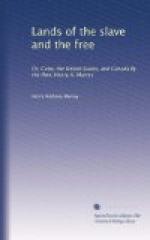Any one who, wandering far from home, finds himself surrounded with utter strangers, will partially understand the pleasure I enjoyed at finding one face I had looked upon before; but to understand it fully, they must know the face I was then gazing upon. Don’t be curious, reader, as to whom it belonged, for I have no intention of enlightening you, further than to say it belonged to her and her husband. Twelve hours of railway makes me sleepy; it’s my nature, and I can’t help it, so I trust I may be excused, when I confess that I very soon exchanged the smile of beauty for the snore of Morpheus. What my dreams were, it concerns nobody to know.
The magnificent brow of hill which overhangs Montreal was named in 1535 Mont Royal, by the famous Jacques Cartier, in honour of his royal master; the French settlement which arose a century after, in the neighbourhood of the Indian village of Hochelaga, assumed the name of the hill, and has at last shaken down into its present combination. What Goths, not to preserve the Indian name which savours of the land and of antiquity, instead of substituting a French concoction! With regard to the site of the town, there is no doubt it is on the island now called Montreal; but where that island is situated may be considered an open question; the river Ottawa runs into the St. Lawrence at the western extremity of the island, and the question is, whether the water on the northern shore is the Ottawa or the St. Lawrence; upon which depends whether the island is in the St. Lawrence, or between the St. Lawrence and the Ottawa. Not wishing to deprive either of their finger in the pie, I should give my verdict in favour of the latter opinion; but I leave it an open question to the reader. The population of the town is increasing rapidly, no doubt owing in great measure to emigration. In 1849 it was 48,000, in 1851, 58,000. The great majority are of the Church of Rome, 41,000; of the Church of England there are 4000; the other denominations are in small numbers.




